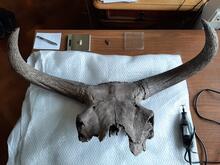Acronym:
LAST
Coordinator:
Bea De Cupere (RBINS) & Quentin Goffette (RBINS)
JEMU partner:
Gontran Sonet & Carl Vangestel
Project summary:
The geographic distribution area of the aurochs (Bos primigenius) during the late Pleistocene – early Holocene was very extensive, including most of Europe, large parts of Asia and North Africa. While in the two latter regions the animal became extinct already quite early, the decline and final extinction of aurochs in Europe gradually took place from the south and west of Europe up to the northeast, the last living specimen in the wild having died in 1627 in Poland. Historical sources describe the presence, management and extinction of the last population in the Polish Royal Forests during the 16th century AD - early 17th century AD.
About 10,000 years ago, the domestication of the aurochs gave rise to the now globally distributed taurine cattle (Bos primigenius f. taurus). Genetic studies support a Near Eastern origin of these domestic cattle, while their appearance in Europe is associated with the Neolithisation and related human migration in the 6th millennium BC. As such, cattle from our regions descend from aurochs domesticated in the Near East and brought to Europe by the first farmers during the Neolithic period.
In the archaeological context, the postcranial skeleton of aurochs and domestic cattle are osteomorphologically separated based on the size of the bones, aurochs being typically larger than domestic cattle. It is, however, not excluded that some of the domestic cattle may have reached the size of either aurochs cows or small aurochs bulls and that large-sized domestic cattle have been misidentified as aurochs. Genetically, ancient mtDNA sequences obtained from B. primigenius specimens show that the majority of Central and Northern European aurochs possess "P" mtDNA haplogroup sequences, which are closely related to, but phylogenetically distinct from, the "T" macro-haplogroup of the domestic cattle, which originates from the Near Eastern aurochs.
Remains of aurochs are found regularly in the prehistoric but much more rarely in the historical record. In the case of Belgium, besides several Pleistocene and early Holocene finds, the possible presence of aurochs at archaeological sites is recorded up to the Roman period (until the 4th - 5th century AD); thereafter the animal seemed to have disappeared from this region. A problem with the Roman finds, however, is the simultaneous presence of exceptionally large domestic cattle which is difficult to discriminate from (smaller) aurochs.
Recently, a horn core of an aurochs has been unearthed in the centre of historic Brussels and dates to the 15th century. This find raises the question of a survival of aurochs much later in our regions than assumed, or – more likely - of an import from refuge areas.
Research objectives:
1) Genetic characterization of the Pleistocene and Holocene aurochs specimens from Belgium.
2) DNA-analysis of the archaeological specimens of aurochs (Neolithic and younger) in order to confirm their osteomorphological identification and allowing to better document the former distribution and extinction of the species.
3) Establish how the DNA-signature of the 15th century horn core from Brussels relates to the genetically known aurochs populations.
Collaborations:
Mietje Germonpré (RBINS), Anton Ervynck (Agentschap Onroerend Erfgoed - AOE)
Lab work progress:
Lab work in progress. Feasibility study completed
Data analysis:
Analysis of preliminary data in progress
Starting date:
2021
Project status:
In progress
